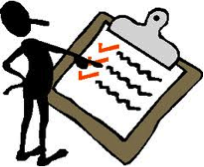“He understands everything I say.”
“He understands. He’s just being bad.”
“He can only do it with me helping him.”
“He knows what I want; he is just not paying attention.”
Have you said or heard another colleague/parent say this about a student?
“It is common to assume that students are comprehending and organizing auditory information than they actually do. Their performance irregularities are attributed to behavior or effort.”
Linda Hodgdon: Visual Strategies for Improving Communication
How do you know when to go to your doctor appointment? How do you know what groceries you need to buy for the week? How do you remember to return messages, go to IEP meetings, when grades are due, or take your children to sports games/birthday parties? You probably use a visual reminder such as a calendar, planner, list, mobile device, computer, etc… . We all use visual supports throughout our day without thinking about it. If we benefit from visual supports then think about how much our students need them.
What are visual supports?
“Visual supports are those things we see that enhance the communication process. Ranging from body movements to environmental cues, visual supports capitalize on a person’s ability to gain information from the sens of sign. Visual supports are an integral part of the communication circle, enhancing effective receiving, processing, action, and expression. Efficient use of supports is a critical part of a person’s communication system. Visual supports include the following forms:”
* Body Language
* Natural Environmental Cues
* Traditional Tools for Organization and Giving Information
* Specifically Designed Tools to Meet Specific Needs
Linda Hodgdon: Visual Strategies for Improving Communication
Rationale
Children with various disabilities often struggle with the use of language to communicate their wants and needs. Visual supports help the child organize, retrieve, and communicate their wants and needs. Anxiety and stress levels are significantly reduced when visual communication supports are added to a child’s daily routine.
Benefits
Visual supports will help individuals who have difficulties with listening, attending, comprehension, responding, processing sequenced information, motivation, play, socializing with peers, following instructions and routines, anxiety and resistance to change, transitioning from one activity to another, social isolation and shyness, asking questions, participating in class discussions, etc… .
All students can benefit from using visual supports, especially those who fit into the following categories: Down Syndrome, Autism Spectrum Disorder, Attention Deficit Hyperactivity Disorder, Language Disorders, Hearing Impairment, Specific Learning Disabilities, Developmental Delay, Oppositional Defiant Disorder, English Language Learners etc… .
AA
